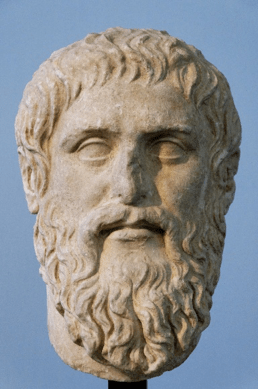By Marina Marren
While Hans Blumenberg’s work on political myth, which has recently come to prominence due, in part, to the publication of Präfiguration, arises in the twentieth century, some of its key ideas have their roots in ancient Greece. It could be argued that Hans Blumenberg’s work on political myth offers a tool that we can use to pinpoint the unjustifiable assumptions and invalid views that uphold the seductive promises of various ideological programs. In this—in its capacity to show to us the mythical and, therefore, precarious foundations of the seemingly most certain political agendas we pursue – Blumenberg’s thinking about myth is akin to Plato’s. It is true that Blumenberg’s thinking on myth takes a critical stance against the overt opposition between myth and rationality (or between muthosand logos) in the Platonic dialogues. But this article will set aside such criticism and will focus, instead, on the points of contact between Blumenberg’s and Plato’s ideas.
Blumenberg’s discussions of the relationship between myth and politics give central stage to a single term—Präfiguration. In shorthand, we can think of Präfigurationas the power of myth to shape politics. It is debated whether Blumenberg discussed Präfigurationin his Arbeit am Mythos (1979). However, in both the latter text and in the essay that is now published in the Blumenberg Nachlass as “AMY II, Mythological Minora, Präfiguration: Napoleon und Hitler / Napoleon und Alexander,” Blumenberg draws on the ancient Greek mythical tradition and turns to Plato’s thought. Blumenberg attributes to mythical prefiguration a paradigmatic function. In his words, “prefiguration is something like a decision aide in that what was once done, requires no renewed consideration and produces no confusion, or helplessness. Under the permanence of conditions dictated (by prefigured) terms, these are decided in advance, as if by a recourse to a paradigm (Paradigma)” (PF, 9, author’s translation). Blumenberg describes a curiously mechanical procedure, although he does not call it so, whereby a state of affairs endowed with mythical significance that once have shaped the past are expected to reproduce the exact same state of events in the future. A paradigm is taken as a stencil that is meant to render a one-for-one copy of the bygone events or to produce a reality that is an exact reversal of the past, call it a “negative” or an “obverse” copy. Blumenberg cites historical examples of such “cut and paste” thinking in Napoleon’s attempts to mimic Alexander and in Hitler’s desire to avenge the defeat of Charles XII (PF, 31 – 32).
In his engagement with Plato, Blumenberg offers reflections on the prefigurative power of the so-called “Ideas” or “Forms.” However, Plato’s and Blumenberg’s thought runs parallel when Plato, in the Statesman, and Blumenberg, in thePräfiguration, address the political power of myth and the formative role that paradigms play in our thinking and in our lives. In Plato’s Statesman, the interlocutors agree that the appropriate paradigm (paradeigma) for rule is weaving and that the best statesman, in some sense, is a weaver (280e). The dialogue ends with this model of political life, but it begins by entertaining an idea that the best ruler is most akin to a shepherd. It is during the discussion of this image—of statesmanship as shepherding of the human herd—that Plato appropriates, for his own purposes, “a great myth” (268d) about the reversal of the sun precipitated by the divine judgment in the strife between Atreus and Thyestes. The mythical story is steeped in violence, cannibalism, and struggle for power. It stands as a palimpsest to Plato’s own mythical story, which also includes a reversal. In Plato’s myth, the course of the rotation of the world changes from time to time and, as a consequence, violent change befalls both animals and humans. The time of destitute and struggle ushers with it the “age of Zeus” during which humans are left to manage their own affairs. The “age of Cronus” is the golden age, which knows neither poverty, nor suffering, but which is free from politics as well as any semblance of economy.
On its surface, life under Cronus is a paradisiac wonderland. We might want to think that our advances in technology, in medicine, in means of communication, and in methods of managing wealth could, at some point, provide for a life that would resemble a halcyon existence under Cronus. However, here Blumenberg’s critical assessment of the delusional power of myth makes an incision into any such hopes of an all-too-peaceful and comfortable future. Perhaps, Plato’s “age of Cronus” is, at once, an image of and a warning against our own proclivity to give up participation in political thought in exchange for economic safety? Reality, such as it is at bottom for human beings, both in Blumenberg’s and in Plato’s accounts, is daunting and harsh. Plato, in the Statesman, portrays an image that is an obverse, albeit delusional, side of burdensome reality. It is an image of life that is perfectly ordered by an omnipotent being where humans do nothing, but enjoy their blessed time. For Blumenberg, we seek to shelter ourselves from “absoluteness” of stark reality and, thus, we readily exchange our political responsibility for mythical political ideas. In other words, between the burden of reality and ourselves we—all too eagerly—place the veil of unarguable (because delusional) myth.
Another similarity that runs through Blumenberg’s and Plato’s thought has to do with the absolutizing or homogenizing power of political mythology. Blumenberg is concerned with the mystical faith in the ability of myth to blind us to the fact that reality has to be assessed on its own terms. The prefiguring power of mythical political ideas compels Napoleon, for example, to resort to the rhetoric of victorious destiny that awaits him in Egypt, just as great conquest was in store in Egypt for Alexander. On the other hand, Napoleon’s failure in Russia, then, becomes Hitler’s point of departure for his purported success in Stalingrad. This latter, as Blumenberg understands it, indicates the reversibility of the mythological prefiguring. To put it otherwise, if a state of affairs acquires a mythico-political significance, it takes on a prefiguring function, which either promises an exact repetition or a perfect reversal of the past. Here, the prefiguring power of myth traverses times and amalgamates peoples – the Russians are to Hitler what the Egyptians are to Napoleon and, prior to that, to Alexander the Great. Although Blumenberg reflects on acts of war and Plato’s Cronus myth promises its absence, there is a striking similarity between the two accounts, which turns on the matter of mythical homogenization of times and peoples.
Cronus provides for such a carefree life that humans are, practically, undifferentiated from animals and all are ruled, as if a single herd. Moreover, there are no seasons under Cronus, but one single, continuously fertile summer. Melissa S. Lane compares the shepherding in the Statesmanmyth to the images of shepherding in the Iliad and the Republic. She inquires:
do shepherds fatten their sheep merely in order to eat them … or is Socrates right to believe in a genuine art of shepherding guided solely by the best interests of the herd? The Statesman’s general account of ruling sustains Socrates’ view that true rulers will have the true interests of the ruled in mind. But this view of ruling cannot be satisfactorily modelled in terms of shepherding. That widely accepted model of rule will be shown to lack both the internal differentiation as an art, and the special (and internal) applicability to humans (45).
Lane focuses on the requirement of “internal differentiation” or on the need to establish the parameters by which we can distinguish between the peculiarities of herding and ruling as well as between ruling Greeks as opposed to Persians, for instance. Her attentiveness to the amalgamation of difference leads Lane to suggest that the rule of Cronus looks like tyrannical rule. Mitchell H. Miller offers the same conceptual view of Cronus’s rule. Miller supports this interpretation with ample historical detail when he compares Cronean time to the period during which Athens is governed by Pisistratus (43–44). Drawing a tacit analogy between the historical Athens and the change of hands that power undergoes in the Stranger’s myth, Miller concludes that “by its own inner dynamic Pisistratus’ tyranny was doomed to give way to the very ‘power of the people’—dēmocratia—which it suppressed” (43–44). Similarly, the myth exhibits an internal necessity according to which the “Golden Age” ceases and is succeeded by the reign of Zeus.

Interestingly, the mythical tyranny of Cronus, which only looks like a lifetime of abundance, but is in actuality a story about the perils of our desire for a completely carefree life—this mythical tyranny—finds its counterpart in the tyranny of historical political myths. On Blumenberg’s analysis, just as on Plato’s, beneath the shimmering surface of glorious and even super-human life, with which political myth beckons, there writhes a most inhuman tyranny. This is the kernel of the failure of the myths’ prefiguring power—not its inability to concoct an image of life and even to transfer it unto reality, but the consequences of such a transfer.
However, the failures are telling. They shine a light on the ways in which our thinking goes astray when we attempt to generate best practices or best forms of government, in this case, by tracing the existing conditions to their supposed—mythical—beginnings and projecting them to the point of their envisioned end. All models built on the grounds of examination of limit-cases or, perhaps, simply all models, are more or less mythical approximations of an extrapolated and imagined state of life. The power of myth, as Blumenberg and Plato tell us, discloses the mythical foundation of the projections that make up the forms of political arrangements, which we impose on ourselves. The myth exposes, also, the elements that are shaped in various ways by the chosen forms of government. These elements—our passions, the needs of finite nature, and the imaginative capacities, which supersede (but do not oppose) the limits of mortal life—are the very things to which we can trace back the constitution of the fabricated images. The reason why it is helpful to see through the images of order, political or otherwise, to which we are accustomed is because questioning their purchase on reality, we attain the distance necessary for rejuvenating the play between the commonplace life and the life of myth.
Marina Marren is an Assistant Professor of Philosophy at the American University in Cairo. She wrote her dissertation on tyranny. Marren currently researches at the intersection of German philosophy and ancient Greek thought. Her forthcoming article ‘Plato and Aristophanes on (Want of) Moral Education: Shame and Eros in Plato’s Gorgias and Aristophanes’ Clouds’ is being published by Ramus: Critical Studies in Greek and Roman Literature.





Leave a Reply